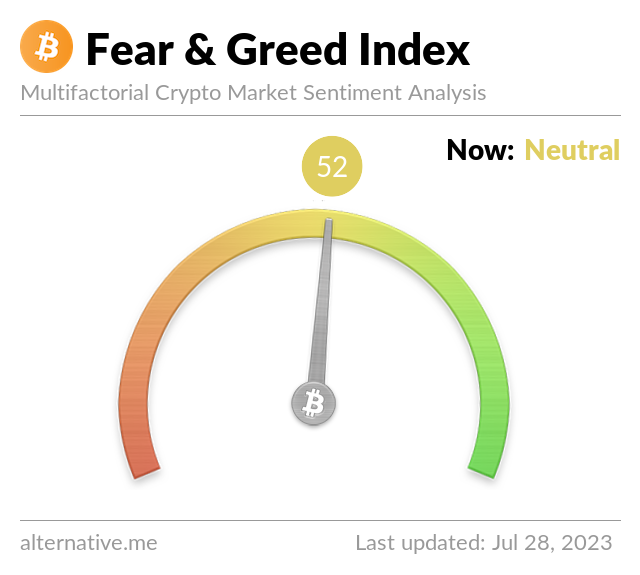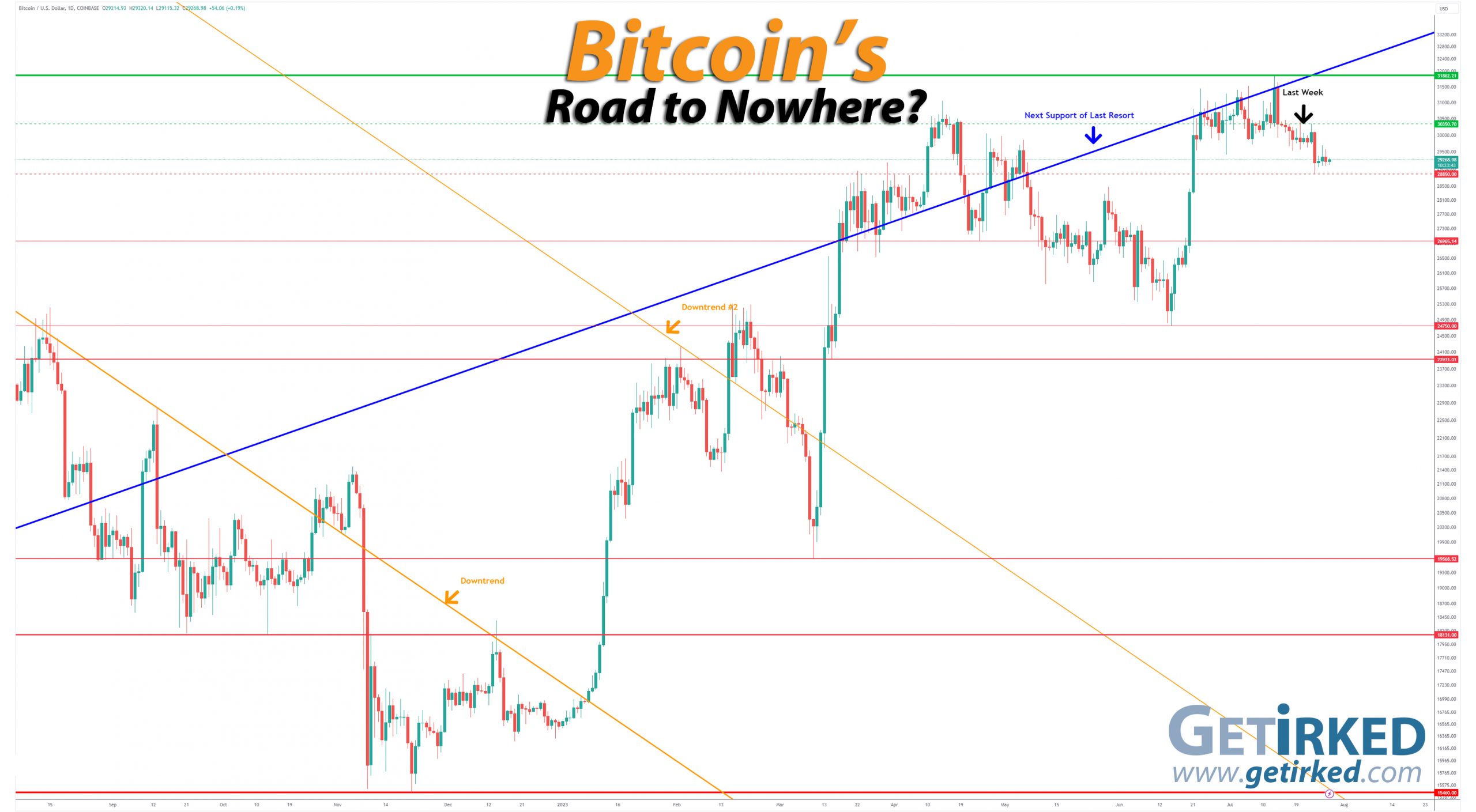Summing Up The Week
A series of positive news catalysts combined to create a bullish environment for stocks this weeks with reports that inflation is cooling, the economy is going strong, and that UPS and the Teamsters might be able to get along.
Let’s take a look at the news that moved markets this week…
Market News
UPS and Teamsters reach tentative contract, avoid strike
On Tuesday, the United Parcel Service (UPS) and its labor union, the Teamsters, reached a tentative contract agreement which would avoid one of the biggest strikes in U.S. history with nearly 340,000 employees potentially striking, reported Forbes.
Going into the week, the possibility of a massive strike was very likely with the potential disruption to much of the shipping in the United States verging on catastrophic, so the announcement of the tentative agreement was welcome news. While the agreement did not make much of an impact on the markets, a strike certainly would have been a pretty massive negative catalyst.
Fed hikes rates 0.25%, Powell implies holding steady
On Wednesday, the Federal Reserve announced they would hike the benchmark interest rate another 0.25% to 5.25%-5.50% and Chair Jerome Powell said the Fed could hold steady in the press conference following the statement’s release, reported CNBC. The market pulled back slightly following the release of the statement, but rallied after Powell hinted the Fed might stop hiking.
What Powell actually said during his press conference (the market loves to infer additional commentary from his words) was that the Federal Reserve would remain “data-driven” for upcoming moves. In other words, another rate hike isn’t necessarily guaranteed – the Fed will continue to hike rates if the data indicates rate hikes are needed.
Regardless, the market, which had already been exuberant with bullish sentiment, took this inference as good news and returned to rallying following the press conference.
U.S. Q2 GDP grew +2.4%, more than 2.0% estimate
On Thursday, the Commerce Department announced that the U.S. Gross Domestic Product (GDP), a key measure of economic activity, grew at a 2.4% annualized pace in Q2, topping estimates of 2%, reported CNBC. Additionally, a key Commerce Department gauge of inflation showed an increase of 2.6%, down substantially from the 4.1% rise in Q1 and well below estimates for 3.2%.
These strong figures reinforce the “soft landing” or “no landing” scenarios, suggesting that the Federal Reserve may actually win in its fight against inflation without causing a recession as initially was predicted.
“It’s great to have another quarter of positive GDP growth in tandem with a consistently slowing inflation rate,” said Steve Rick, chief economist at TruStage. “After yesterday’s resumption of interest rate hikes, it’s encouraging to see the aggressive hike cycle working as inflation continues to decline. Consumers are getting a reprieve from the rising costs of core goods, and the U.S. economy is off to a stronger start to the first half of the year.”
Europe raises interest rates by 0.25%
On Thursday, the European Central Bank (ECB) raised its benchmark interest rate another 0.25% to 3.75%, saying inflation “is still expected to remain too high for too long,” reported CNBC. Europe continues to see a much higher rate of inflation than that seen in the United States currently at 5.5% in June, far above the ECB’s 2% target.
However, a lot of the difference in rate of inflation between the U.S. and Europe could be attributed to the dramatic difference in benchmark interest rates: the U.S. is set to 5.25%-5.50% and the ECB is still much lower at 3.75%.
Bank of Japan loosens Yield Curve Control
Unlike the rest of the world’s economies where inflation has been the biggest concern, Japan has faced deflationary pressures since its market collapse in the 1990s. As a result, the Bank of Japan (BoJ), the country’s central bank, has adhered to a policy of strict yield curve control, locking in rates on its bonds in an attempt to prevent further deflation, an effect many economists consider more damaging to an economy than in flation.
Well, on Thursday, the Bank of Japan announced that it would loosen its yield curve control and shocked the rest of the world’s markets, reported CNBC. As a result, stocks and bonds sold off Thursday as such a dramatic shift in an economic policy that has been in place for decades will almost certainly have widespread effects on the world’s economies.
… don’t worry, though, because stocks recovered once more on Friday.
PCE, key Fed inflation gauge, falls to lowest level in 2 years
On Friday, the Personal Consumption Expenditures (PCE) index showed an increase of 4.1% from last year, beating estimates for a 4.2% increase, and the lowest increase since September 2021, reported CNBC. The PCE is the preferred gauge of inflation for the Federal Reserve Bank, so its continuing disinflation is a good sign that the Fed’s actions are having positive effects. Naturally, stocks completely regained any losses (and more) that they saw on Thursday following the B o J announcement.
“Today’s economic releases reaffirm the current market narrative that inflation is cooling and economic growth is continuing, which is a favorable environment for risk assets,” said George Mateyo, chief investment officer at Key Private Bank. “The Fed and investors will take comfort in these numbers as they suggest that the inflation threat is dissipating and thus the Fed may now be able to go on vacation and assume an extended pause with respect to future interest rate increases.”
Next Week’s Gameplan
With the Fed Meeting now behind us, the catalysts for next week are Big Tech earnings as Apple (AAPL), Amazon (AMZN), and a slew of other tech companies will give their quarterly reports throughout the week. Additionally, we’ll also see the job reports for July coming on Friday which will provide some insights into the health of the U.S. economy.
For the moment, the seasonal summer rally seen every year seems to be the scenario that will play out, and we’re just going to head further into “Selling Season” with me looking at each of my positions to determine where to take profits.
I hope everyone enjoys this summer reprieve and I’ll see you back here next Friday!
This Week in Play
Stay tuned for this week’s episodes of my two portfolios Investments in Play and Speculation in Play coming online later this weekend!
Crytpo Corner

Bitcoin Price (in USD)
%
Weekly Change
Bitcoin Price Action
Bitcoin loses monthly support level…
Bitcoin initially rallied over the weekend, unable to break previous highs and setting a new weekly resistance at $30,350.70 before rolling over and selling off. Bitcoin sold off on Monday, dropping through both support levels and not establishing a new low until $28,850.00.
As I said I thought might happen in last week’s video, when Bitcoin broke through last week’s support at $29,525.00, the monthly support at $29,417.14 also didn’t stand a chance.
From here, our key levels are now $30,350.70 on the upside and $28,850.00. Since the last big move was to the downside and the recovery has been weak, at best, technical analysis suggests we can expect a test of the weekly low with potential further breakdown with the next big area of support around $27,000.
The Bullish Case
Bulls are trying to make the argument that consolidation above the $29,000 level indicates a lot of buying support. Some Bulls believe Bitcoin might see a brief test of the $28,500, but that Bitcoin will hold that level without going lower as more buyers are eager to snap up whatever Bitcoin they can get at those prices.
The Bearish Case
Bears have taken the upper-hand this week now that $30K as well as key lower levels of support have given way. With the Federal Reserve’s announcement of an additional 0.25% rate hike this week and China experiencing a deflationary recession, the Bears argue that Bitcoin has no chance and will sell off from these levels and deep into the low $20K region.
Bitcoin Trade Update
Current Allocation: 0.667% (+0.067% since last week’s update)
Current Per-Coin Price: $30,342.29 (-0.34% since last week’s update)
Current Profit/Loss Status: -3.54% (-1.54% since last week’s update)
Bitcoin started triggering my buy orders when it sold off on Monday with my first buy going through at $29,670.00 and my lowest buy of the week hitting at $29,097.30, giving me a $29,440.34 average buying price (after trading fees).
The combined buys lowered my per-coin cost -0.34% from $30,445.93 to $30,342.29 and raised my allocation +0.067% from 0.600% to 0.667%.
Bitcoin Buying Targets
Using Moving Averages and supporting trend-lines as guides, here is my plan for my next ten (10) buying quantities and prices:
0.027% @ $28,939
0.027% @ $28,518
0.027% @ $27,876
0.033% @ $26,579
0.173% @ $25,737
0.076% @ $25,454
0.179% @ $24,854
0.434% @ $23,660
0.786% @ $22,184
0.569% @ $21,521
Not Your Keys, Not Your Crypto…
In light of brokerage failures in 2022, I no longer keep any of my crypto on an exchange and I only keep enough USD on the exchanges I use to execute my next few buys. I use multiple cold wallets from the brands Ledger and Trezor to hold my crypto (click the links to access the direct sites, and I receive no affiliate benefits from these links).
Additionally, I have now divided my allocated USD between two different exchanges – Gemini and Coinbase – in case one (or both) becomes insolvent. Disclaimer: We both receive a bonus if you use either my Gemini or Coinbase referral links to open accounts.
I do not trust anyone in the space, even with Coinbase (COIN) being publicly traded (and one of my own Investments in Play positions).
No price target is unrealistic in the cryptocurrency space – Bullish or Bearish.
While traditional stock market investors and traders may think the price targets in the cryptocurrency space are outlandish due to the incredible spread (possible moves include drops of -90% or more and gains of +1000% or more), Bitcoin has demonstrated that, more than any speculative asset, its price is capable of doing anything.
Here are some of Bitcoin’s price movements over the past couple of years:
- In 2017, Bitcoin rose +2,707% from its January low of $734.64 to make an all-time high of $19,891.99 in December.
- Then, Bitcoin crashed nearly -85% from its high to a December 2018 low of $3128.89.
- In the first half of 2019, Bitcoin rallied +343% to $13,868.44.
- In December, Bitcoin crashed -54% to a low of $6430.00 in December 2019.
- In February 2020, Bitcoin rallied +64% to $10,522.51.
- In March , Bitcoin crashed nearly -63% to a low of $3858.00, mostly in 24 hours.
- Then, Bitcoin rallied +988% to a new all-time high of $41,986.37 in January 2021.
- Later in January 2021, Bitcoin dropped -32% to a low of $28,732.00.
- In February, Bitcoin rallied +103% to a new all-time high of $58,367.00.
- Later in February, Bitcoin dropped -26% to a low of $43,016.00.
- In April , Bitcoin rallied +51% to a new all-time high of $64,896.75.
- In June , Bitcoin crashed -56% to a low of $28,800.00.
- In November, Bitcoin rallied +140% to a new all-time high of $69,000.00.
- In November 2022, Bitcoin crashed -78% to a low of $15,460.00.
- In April 2023, Bitcoin rallied +101% to a high of $31,050.00.
- In June, Bitcoin dropped -20% to a low of $24,750.00
- In July, Bitcoin rallied +29% to a high of $31,862.21.
Where will Bitcoin go from here? Truly, anything is possible…
What if Bitcoin’s headed to zero?
The only reason I speculate in the cryptocurrency space is I truly believe Bitcoin isn’t headed to zero. I am prepared for that possibility, however, by knowing I could potentially lose all of the capital I’ve allocated to this speculative investment. Professional advisers recommend speculating with no more than 5% of an investor’s overall assets. Personally, I’ve allocated less than that to speculating in crypto. I feel that anyone who doesn’t fully believe in the long-term viability of cryptocurrency would be better served not speculating in the space. On a good day, this asset class isn’t suitable for those with weak stomachs. On volatile days, the sector can induce nausea in the most iron-willed speculator. If a speculator isn’t confident in the space, the moves will cause mistakes to be made.DISCLAIMER: Anyone considering speculating in the crypto sector should only do so with funds they are prepared to lose completely. All interested individuals should consult a professional financial adviser to see if speculation is right for them. No Get Irked contributor is a financial professional of any kind.


